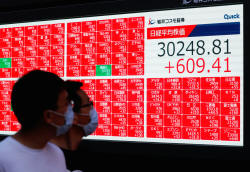Shares staunch bleed after worst selloff since January
 Send a link to a friend
Send a link to a friend
 [September 29, 2021] By
Marc Jones [September 29, 2021] By
Marc Jones
LONDON (Reuters) - Investors sought to
staunch the bleed on Wednesday after world stocks suffered their worst
rout since January and U.S. and European borrowing costs raced to their
highest in months.
Asia managed to slow the falls and the pan-European STOXX 600 index
bounced 1% in early trading after shedding 2.2% on Tuesday and after a
heavy selloff in U.S. tech stocks consigned Wall Street to its steepest
drop since mid-July. [.N]
The global benchmarks for borrowing costs - the yields on U.S. and
German government bonds - also edged lower after their spikes had helped
fuel the volatility. Traders were also waiting to hear from the heads of
the European Central Bank, the U.S. Federal Reserve, Bank of Japan and
Bank of England who speak together at an ECB event later
https://www.ecb.europa.eu/pub/
conferences/
html/20210928_ecb_forum_
on_central_banking.en.html.
"The question that will come in the next 10 days is will the U.S.
Treasury yield keep pushing above 1.5%," said Societe Generale
strategist Kenneth Broux. "That was a sort of breaking point for broader
risk assets when stops went off and the selloff started accelerating."

Those Treasury yields have jumped roughly 20 basis points over the last
week and are set for their biggest monthly jump since March. German and
British 10-year bond yields are set for the biggest month rise since
February -- gilt yields have soared almost 40 bps this month to 1%.
Broux said the question for October and the rest of the year would be
whether the inflation pressures that central banks train their focus on
start to abate. "The 1.5% level (on U.S. Treasuries) is really pivotal,"
he said.
In the currency markets, the run up in yields, prompted by the signs
that some Fed members want to start moving interest rates up next year,
saw the dollar touch an 18-month high against the yen and set its
highest level of the year versus other major peers. [FRX/]
It is also on course for its best year since 2015 just as doubts
re-emerge about the global recovery from the COVID pandemic, Washington
is bogged down in debt ceiling talks that could lead to a government
shutdown. China is also grappling with a power crunch and property
sector worries that have hit its economy.
QUARTER OF STRAIN
U.S. Futures suggested a risk-friendlier mood could return on Wall
Street later too. S&P 500 e-minis were up 0.6% and those for the Nasdaq
were up 0.8% after that index was pounded 3.6% on Tuesday by heavy
selling of super-sized tech firms such as Google, Amazon and Microsoft.
[.N]
Overnight Asia-Pacific shares had managed to restrict falls to 1.2%. Not
including Japan, the region was heading for a 9.4% decline for the third
quarter, its worst quarterly performance since the first three months of
2020, when global markets were roiled by the initial spread of COVID-19.
[to top of second column] |

Men wearing protective face masks amid the coronavirus disease
(COVID-19) outbreak look at an electronic board displaying Japan's
Nikkei Index outside a brokerage in Tokyo, Japan, September 24,
2021. REUTERS/Kim Kyung-Hoon

MSCI's 50-country ACWI world stocks index is heading for its first red quarter
since then too.
Other standout moves have been a 60% surge in gas prices and coffee beans have
jumped 25% for second quarter in a row. The Baltic Dry index of global freight
prices has surged 40% to add to 50% and 65% rises in previous two quarters,
while China's woes have sent iron ore crashing 45%, which will be its worst
quarter on record.
"We still see inflation as a risk, but our base case is that it will be
transitory and come back to more normal levels during next year," said Osman
Sattar, S&P Global's Director for EMEA Financial Institutions.
But companies will face pressure on margins as higher energy prices get locked
into next year's bills, he added.
ROTATE TO VALUE
China's worsening power crunch pushed investors out of Chinese stocks vulnerable
to factory shutdowns, including chemicals and steelmaking, even as the country's
economic planning agency sought to reassure residents and businesses.
Debt saddled property giant China Evergrande's shares did leap 15% though, after
it said it planned to sell a 9.99 billion yuan ($1.5 billion) stake in Shengjing
Bank.
But investors are still waiting to see whether the developer makes some now
overdue bond payments and rating firm S&P Global said another major property
firm, Fantasia, was also at growing risk of default.
In the commodity markets, oil prices dropped having broken through $80 a barrel
for the first time in nearly three years the day before. Brent crude fell 0.5%
to $78.70 per barrel U.S. crude dipped 0.6% to $78.85 a barrel. [O/R]

Safe haven gold edged higher in the metal markets with the spot price at
$1,739.5 an ounce, up 0.4% from the seven-week low hit the day before as higher
yields hurt demand for the non-interest bearing asset.
(Additional reporting by Alun John in Hong Kong and Dhara Ranasinghe and Sujata
Rao in London; Editing by Edmund Blair, Kirsten Donovan)
[© 2021 Thomson Reuters. All rights
reserved.] Copyright 2021 Reuters. All rights reserved. This material may not be published,
broadcast, rewritten or redistributed.
Thompson Reuters is solely responsible for this content. |